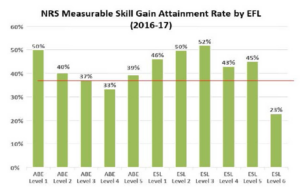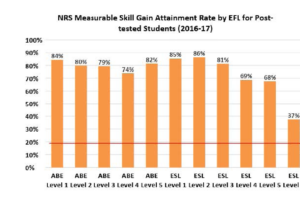Setting and Achieving Goals: The Role of Assessment
by Heidi Silver-Pacuilla and Thomas Suh
Many of us set New Year’s resolutions to lose weight, exercise more, eat more greens, call our mothers more regularly, or learn a new skill. All of these resolutions stem from a motivation to improve something – our habits, our health, our relationships, or our resume. Setting the goal and articulating it to family and friends is an important first step to reinforce that motivation and activate a support system. Acting on the goal and tracking incremental progress are equally important and reinforcing. If you made a resolution, how are you tracking your progress? How does progress feel? Is your support network cheering you on?
Students enter our programs with the drives of motivation and determination. They’ve acted on their goals and often have shared them with their families and friends. We hope our classrooms and programs reinforce students’ motivation and persistence. Other articles in this edition of PROGRESS focus on motivating adult education staff as well as learners, describe an interviewing technique to help increase student motivation, and demonstrate how giving students the opportunity to persist in reading longer texts can build skills and transform attitudes. This article looks at the role assessment data can play in reinforcing motivation and supporting progress.
Tracking Educational Progress
As you know, every new student must be administered a pre-test upon registration. The scores on the pre-test plus the information shared about availability, goals, and interests during intake help the program identify an appropriate instructional level and schedule for each student. The assessment score sets a baseline against which to track educational progress. It can make the incoming level of performance visible to both the student and the teacher and help students understand their placement and how to pace themselves to undertake the work required to achieve their goals.
Standards-based instruction (SBI) in the classroom makes the learning visible to the students on a daily basis. SBI makes explicit the standards being taught, relates individual lessons to a larger unit, and engages students in formative, classroom-based assessments on the content and concepts that are learned within that unit. As students persist in attendance and engage in their learning, they can “see” their progress, but that can be hard to quantify or share with their support network.
Post-testing as soon as it is appropriate (required length of instructional time between pre- and post-test depends upon the assessment your program is using) provides students with a more tangible indicator of progress. Post-testing demonstrates whether the instruction has been effective for the learners or whether adjustments should be made, and whether students are ready to advance.
Did you know? It is Virginia Assessment Policy to post-test 70% of all participating students.
Tracking Progress at the State Level
The aggregate statewide performance rate, called Measurable Skill Gain (MSG) under the Workforce Innovation and Opportunity Act (WIOA), is reported to the Virginia Board of Workforce Development as progress toward the goals of the 2016 WIOA State Plan for the Commonwealth of Virginia and to the federal Department of Education in the end-of-year performance report. For program year 2016- 2017, the target overall MSG rate for adult education was set in negotiation with the federal Department of Education at 42 percent. Virginia reported a statewide MSG attainment rate of 40 percent, two points below the target. For program year 2017-2018, the current program year, the target overall MSG rate for adult education was set at 43 percent.
The following chart shows the statewide performance of participants grouped by Educational Functioning Level (EFL) for the total enrollment of 19,208 students; the red horizontal line is set at the 42 percent target attainment rate. Participants in some EFLs exceeded that target (ABE Level 1, ESL Levels 1-5), but participants in other EFLs fell below the target level of performance (ABE Levels 2-5, ESL Level 6). While this chart includes the performance of all participants, whether they had received a post-test or not, it does not indicate the enrollment within each EFL, which impacts the overall performance average for the state.


As we looked at the statewide performance data from 2016-2017, we noticed that many programs could be doing more to capture post-test data. Only 10,450 of our total 19,208 students were post-tested in 2016-2017. This represents a 54 percent post-test rate, well below the state policy requirement of 70 percent. What the MSG attainment rate for post-tested students demonstrates is that when students persist in instruction and are post-tested, they show remarkable gains. The following chart shows the statewide performance by EFL for the 10,450 students who took a post-test. The MSG rates are well above the 42 percent target in all but one EFL.
What factors play into students receiving a post-test? Given the high MSG attainment rate of post-tested students, the quality of instruction of adult education providers appears to be strong. However, the stop-out rate prior to post-testing is concerning. Retention and regular attendance are necessary for students to accrue enough instructional hours to be eligible to post-test. Program and classroom policies and practices that track instructional hours and arrange for post-testing as soon as appropriate are also necessary.
What Can You Do?
Discuss with colleagues and students the role post-test data can play in supporting motivation and persistence. What do students need to know about assessment data to help them understand their progress?
Become informed about the post-test rate in your program and region and how your program is implementing the related policies and delivering engaging instruction. Set a goal, share it with others, take a baseline measurement, and start tracking progress toward achieving a higher MSG for your students, class, region, and the state!
Heidi Silver-Pacuilla is Adult Education Coordinator at the Office of Career, Technical, and Adult Education in the Virginia Department of Education (VDOE). Thomas Suh is the Adult Education Data Collection, Reporting, and Accountability Specialist at VDOE.